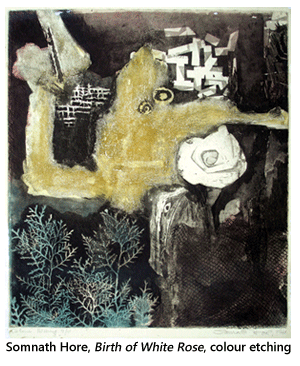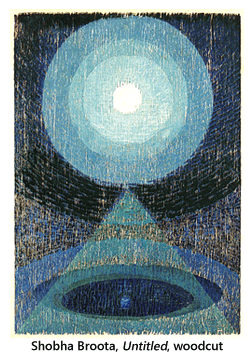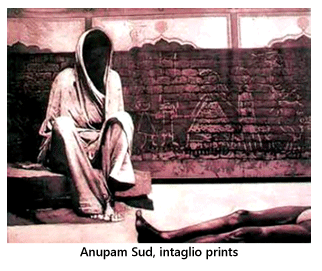- Publisher's Note
- Editorial
- Love of Life (that) Spills Over
- A Continuing Multiplication
- From Painting to Print
- Intimate Involvement
- Portrait of the Artist as an Old Man
- (Hi)Story of the Garhi Printmaking Studios, New Delhi
- Surinder Chadda
- Ramendranath Chakravorty
- Group 8
- Mother and Child: A Screenplay
- Straddling Worlds
- A Brief History of Printmaking at Santiniketan
- Vignettes from History
- Southern Strategies
- The Forgotten Pioneer: Rasiklal Parikh
- Printmaking in the City Of Joy
- Amitabha Banerjee: His Art and Aesthetic Journey
- Local Style and Homogenizing trends: Early Medieval Sculpture in Galaganatha
- English China: Delicate Pallid Beauty
- The Beauty of 'Bilal'
- Photo Essay
- The Way of The Masters: The Great Artists of India 1100 –1900
- Striving Towards Objectivity
- The Art of Sculpting In the Contemporary Times
- An Artistic Framework for an Alternative to Ecology
- Bidriware and Damascene Work in Jagdish and Kamla Mittal Museum of Indian Art
- A Lowdown on the Print Market
- The 'bubble' and the 'wobble'
- What Happened and What's Forthcoming
- Art Bengaluru
- Art Events Kolkata: June – July 2011
- Musings from Chennai
- Mumbai Art Sighting
- Previews
- In the News
- Christie's Jewellery Auction at London, South Kensington
ART news & views
Group 8
Volume: 3 Issue No: 19 Month: 8 Year: 2011
One of India's most influential printmaking associations re-explored
by Uma Prakash
Though commercial printmaking in India had existed for years in the form of colonial engravings, Battala woodcuts, and Raja Ravi Varma oleographs, it was only in the 20th century that contemporary Indian prints originated as a fine art and artists refined printmaking into an independent medium of expression. Somnath Hore, the father of modern lndian prints, worked and experimented widely with the medium under the initial guidance of Krishna Reddy, who had been greatly influenced by master printmaker Stanley William Hayter at his famed Atelier 17 in Paris.
a fine art and artists refined printmaking into an independent medium of expression. Somnath Hore, the father of modern lndian prints, worked and experimented widely with the medium under the initial guidance of Krishna Reddy, who had been greatly influenced by master printmaker Stanley William Hayter at his famed Atelier 17 in Paris.
In 1958 Hore was the head of the Printmaking Department, College of Art, Delhi. He had won the National Award for a colour etching called Birth of a White Rose. He was soon associated with his images of mother and child, man and animal, his use of cubist schematic elements, and his working with monotones or colour viscosity printing from the same plate. Somnath Hore had acquired an old printing machine which was used as an etching machine. NB Joglekar, printmaker at the Fine Arts Department, MS University, Baroda, worked as not only the external examiner but also brought surplus material for the Delhi students.
Somnath Hore and Jagmohan Chopra were determined to take printmaking to a more serious level. Chopra said (in a conversation with Gayatri Sinha) that the student community responded well to the engrossing technicalities of printmaking. Hore used to tell the students to work on different permutations and combinations in just one plate in order to learn the vocabulary of printmaking. In this way Hore and Chopra had a student working on a plate for a whole year. The duo managed to spread awareness among the artists that they had struck on a very special medium, namely printmaking. The artists were fascinated by the textures and visuals that could be produced through different processes such as lithographs,  etchings, monoprints and woodcuts, which would not be possible in paintings or drawings.
etchings, monoprints and woodcuts, which would not be possible in paintings or drawings.
When Jagmohan Chopra founded "Group 8" in 1968, in New Delhi, new doors for this unique art form were finally opened. The fraternity of the printmaking artists was given an identity. Chopra had created an association of working artists, all of whom were devoted to printmaking. He felt that this completely neglected medium needed both more focus and more recognition. After the two wars there was an acute shortage of metal. Even though resources for making art were in short supply, Chopra designed and built a printmaking machine and made it available in his living room to the Group 8 artists which comprised of Jagdish De, Umesh Varma, Prashant Vichitra, Lakshmi Dutta, Jagmohan Chopra, Yogshakti, Surinder Chopra and the youngest of the members, Anupam Sud. Furthermore, Chopra tried to create an awareness of printmaking's many possibilities through his textual surfaces and vigorous abstractions.
Group 8 held their first exhibitions of all-India prints at the Lalit Kala Akademi and the India Fine Arts and Crafts Society. The group also developed links to exhibit in Baroda, Calcutta and Hyderabad. They often used the inexpensive cardboard-based collograph instead of the more expensive etching processes. Thanks to their holistic attitude they included photographer Raghu Rai and invited arts citric like Keshav Malik, Richard Bartholomew, SN Krishna and Krishna Chaitanya to experiment and create their own prints.
According to Anupam Sud, “Once one had graduated from college there was no place to do printmaking and this was at the back of our mind even when we were students. I distinctly remember speaking very disparagingly about printmaking the first time I went to the studio, voicing my fears about the uselessness of printmaking as an art pursuit. As a technologically mediated form of expression it requires huge initial expenses and it can never be a solitary pursuit like painting. I think Mr Chopra's response to our scene of disquiet was bighearted to say the least. He set up a workshop in his house and all flocked to it to make works. It became the hub of activities with whoever was in town visiting the studio to see what we were up to. The number of artist who worked there is simply amazing: Prashant Vichitra, Jagdish Dey, Umesh Verma these are just a few names that I can name. Mr Chopra had a much larger vision and he built up associations with likeminded artists in other cities. Even painters from Baroda like Gulam Sheikh were deeply attracted to printmaking. Needless to say the community of printmakers in Baroda, like Jyoti Bhatt, P Dhumal, and Rini Dhumal, as well as artists from Hyderabad and Calcutta, all participated actively in our exhibitions with great enthusiasm. Moreover, research scholars like Laxmi Dutta Gupta, Paneerselvam and others also worked with Chopra. Later, in the early 70's, Shobha and Rameshwar Broota, who had become printmaking enthusiasts as well, invited Mr Chopra to set up a printmaking studio at the Silpi Chakra”
speaking very disparagingly about printmaking the first time I went to the studio, voicing my fears about the uselessness of printmaking as an art pursuit. As a technologically mediated form of expression it requires huge initial expenses and it can never be a solitary pursuit like painting. I think Mr Chopra's response to our scene of disquiet was bighearted to say the least. He set up a workshop in his house and all flocked to it to make works. It became the hub of activities with whoever was in town visiting the studio to see what we were up to. The number of artist who worked there is simply amazing: Prashant Vichitra, Jagdish Dey, Umesh Verma these are just a few names that I can name. Mr Chopra had a much larger vision and he built up associations with likeminded artists in other cities. Even painters from Baroda like Gulam Sheikh were deeply attracted to printmaking. Needless to say the community of printmakers in Baroda, like Jyoti Bhatt, P Dhumal, and Rini Dhumal, as well as artists from Hyderabad and Calcutta, all participated actively in our exhibitions with great enthusiasm. Moreover, research scholars like Laxmi Dutta Gupta, Paneerselvam and others also worked with Chopra. Later, in the early 70's, Shobha and Rameshwar Broota, who had become printmaking enthusiasts as well, invited Mr Chopra to set up a printmaking studio at the Silpi Chakra”
Being the youngest entrant to Group 8, Anupam Sud had the rich experience of learning from Jagmohan Chopra. “He was always very experimental and he never let anything come in his way to achieve what he set out to do.  His experiments with collography for example were a result of the shortage of art material caused by the string of border wars that India entered into in the 1960's. With no zinc plates to work with, he sought inexpensive substitutes resorting to cardboard as a matrix. One knows Kanwal Krishnaji had set up his own press and experimented with the medium in the 1950's, but his was a solitary pursuit. Professor Chopra had a different position…a community oriented approach. One of the things that Professor Chopra recognized was the need for inexpensive substitutes for materials and sourcing from local agencies for equipment, inks and paper. In fact he enthused everyone so much that I distinctly remember that the gentleman who made the printing press for him in Turkman Gate even postponed his marriage which was to be solemnized in Pakistan so that he could finish making the etching press for him! The press itself was a derivative of a sugar cane juice extractor. The mechanics of the machine were quite similar to an etching press. With relevant modifications Mr Chopra was able to devise a perfectly acceptable indigenously designed intaglio printing press.” (Anupam Sud in conversation with Shukla Sawant and Subba Ghosh from Transgression in Print: Anupam Sud (Four Decades) edited by Geeti Sen 2007)
His experiments with collography for example were a result of the shortage of art material caused by the string of border wars that India entered into in the 1960's. With no zinc plates to work with, he sought inexpensive substitutes resorting to cardboard as a matrix. One knows Kanwal Krishnaji had set up his own press and experimented with the medium in the 1950's, but his was a solitary pursuit. Professor Chopra had a different position…a community oriented approach. One of the things that Professor Chopra recognized was the need for inexpensive substitutes for materials and sourcing from local agencies for equipment, inks and paper. In fact he enthused everyone so much that I distinctly remember that the gentleman who made the printing press for him in Turkman Gate even postponed his marriage which was to be solemnized in Pakistan so that he could finish making the etching press for him! The press itself was a derivative of a sugar cane juice extractor. The mechanics of the machine were quite similar to an etching press. With relevant modifications Mr Chopra was able to devise a perfectly acceptable indigenously designed intaglio printing press.” (Anupam Sud in conversation with Shukla Sawant and Subba Ghosh from Transgression in Print: Anupam Sud (Four Decades) edited by Geeti Sen 2007)
Though she was the youngest member of Group 8, Anupam Sud went on to become one of the most significant women artists of her generation. She has used the intaglio process in all its variations: etching and drypoint in combinations with the viscosity process and advanced wiping technology. Restraint is the keynote of her work. While her sympathies and concerns are often feminist, a recurring theme in her work is the universal human predicament.

Many artists who were primarily painters also experimented with printmaking, often inspired by the efforts of Group 8. Veteran Bengali artist Paritosh Sen claimed that, "You cannot be a good printmaker if you are not a good painter." Numerous famous Indian painters like MF Husain were responsible for the proliferation of printmaking into diverse techniques, mediums, and technologies, and their influence fed the growing demand for prints in the current market. Artists who found themselves attracted to printmaking included senior masters such as Amitabha Banerjee, Lalu Prasad Shaw, Laxma Goud, Paramjit Singh, Sanat Kar; and more recent artist/printmakers like Swapan Kr Das, Anupam Sud, Shukla Sen Poddar and Anita Chakravarty. While Sanat Kar evolved wood intaglio, cardboard intaglio and sun mica engravings, Swapan Das leads the international coterie of printmakers in the multiplicity of colour gradations that can be introduced into a single linocut up to 130 in some of his works.
Although prints are cheaper than paintings, they retain exclusivity because of the limited editions that are permitted to bear the artist's signature. The number of editions made from each plate is limited, and the matrix is thereafter broken or cancelled by slashing through with a diagonal line. Printmaking is tedious as the entire process is executed by the artist himself, and exposes the artist to acidic fumes and physically stressful working conditions…a fact that is little known to many casual collectors.
Images Courtesy: W.X.W. Collection | Art Heritage Gallery | Delhi Art Gallery | Gallery Rasa